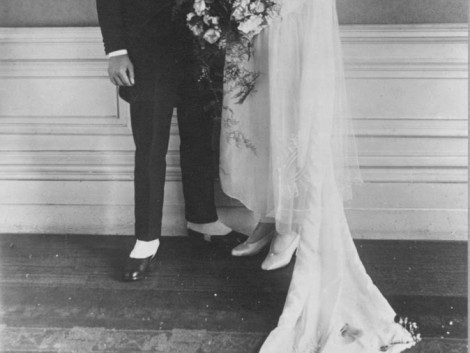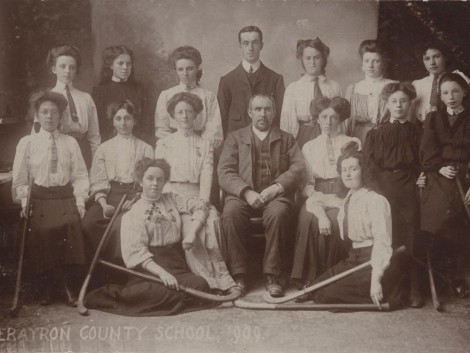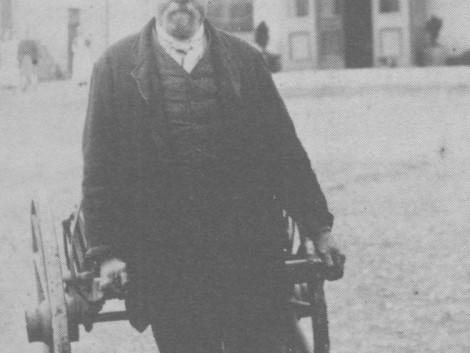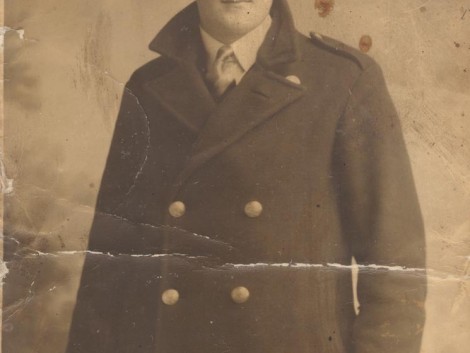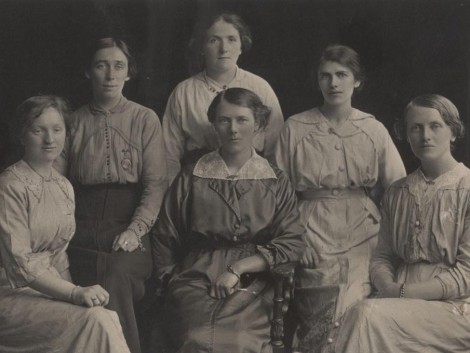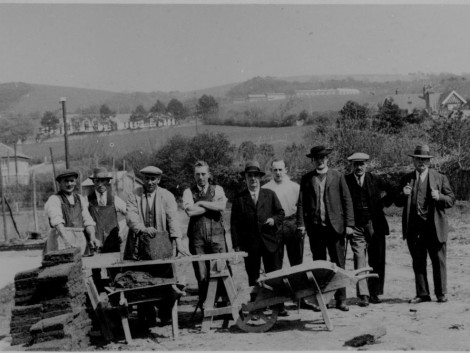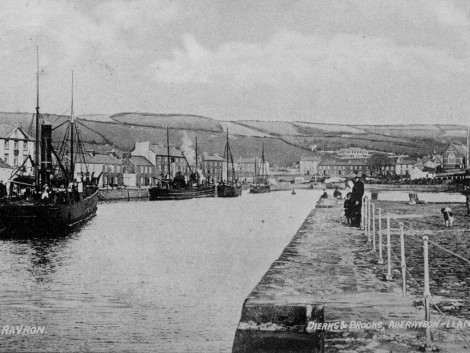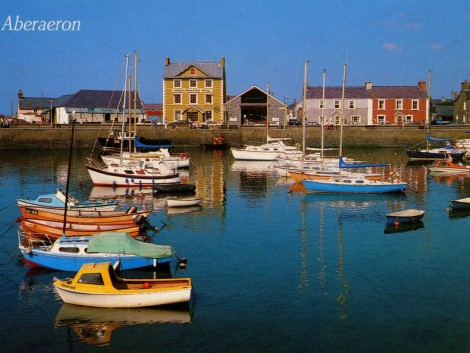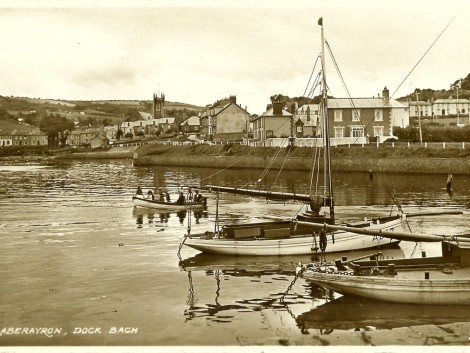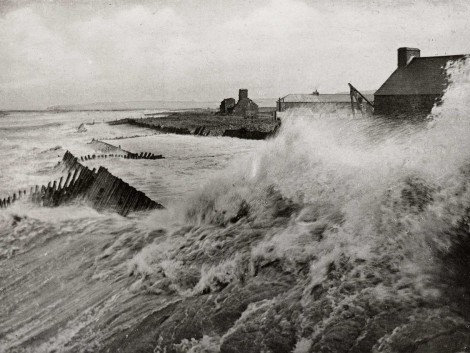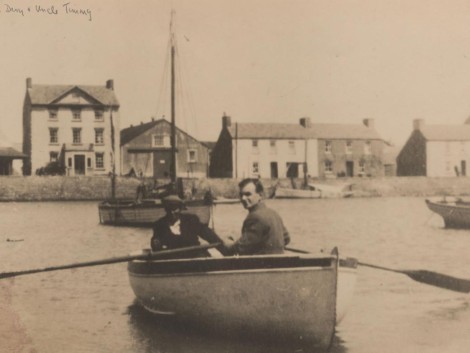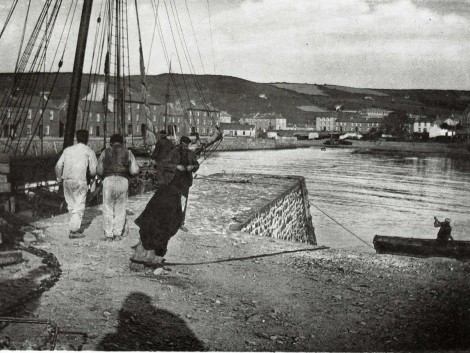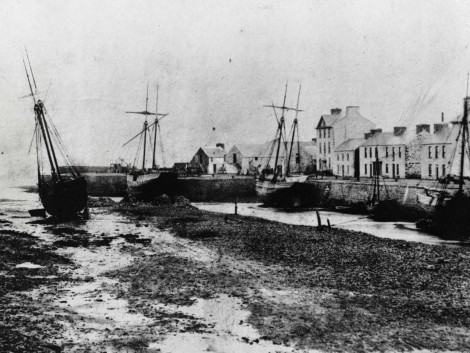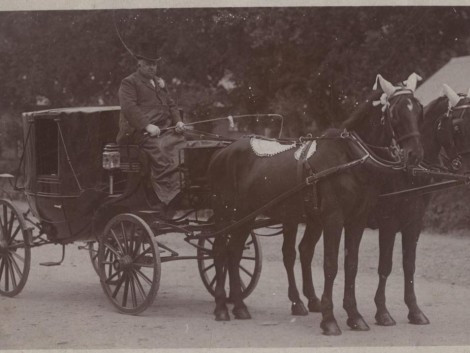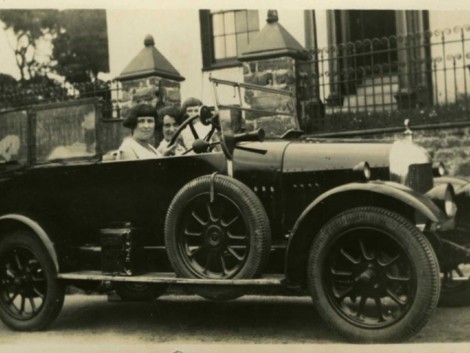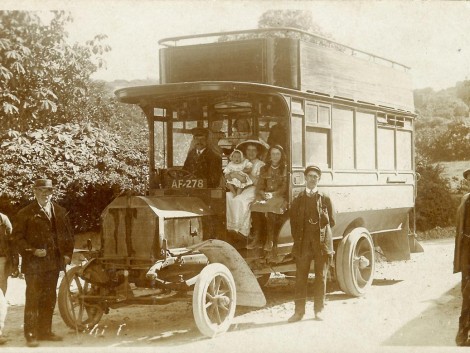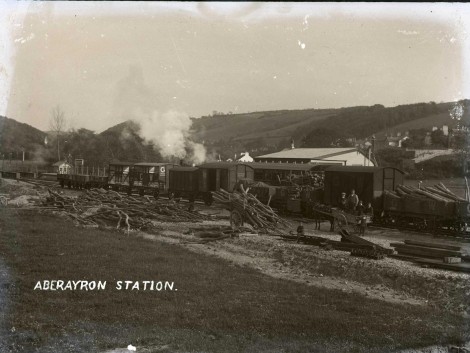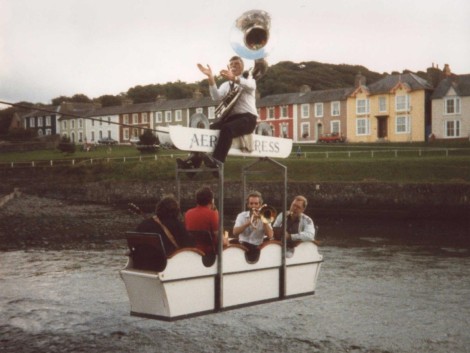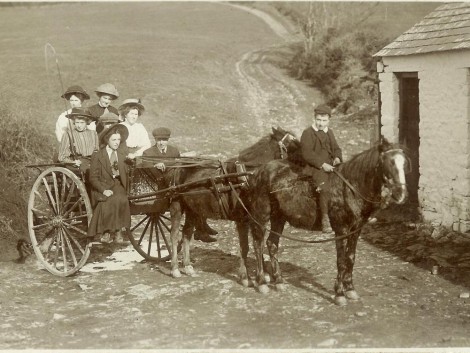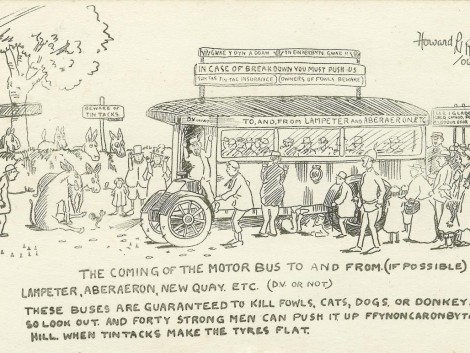Sorry, this entry is only available in British English.
Author Archives: admin
(Cymraeg) Henry Jones: Y Stesion a’r Hen Fysiau (2011)
(Cymraeg) Doris Jones: Atgofion (2011)
(Cymraeg) Cynog Dafis: I Lanbed i’r Pictiwrs ar y Trên (2011)
Lloyd Thomas: Transport (2007)
(BASED ON EXTRACTS FROM A TRANSCRIPT OF A RECORDED INTERVIEW WITH LLOYD THOMAS, 2007)
Oh, Aberaeron’s changed a lot since my day, when I was a kid. It was quite a busy town. A lot of people used to come in then, in horse and cart. There were cars, of course, but the old-fashioned cars.
My father was on sea and he used to send telegrams in those days. (Remember the little, yellow little envelopes?) They used to come through the post office to say ‘Arrived safe in Liverpool, home on the 8:15 train tonight.’ There used to be trains then, and I used to run up to the station then to meet him and then, if he‟d been away for six months, he‟d probably be home for a month or five weeks and then be waiting for another ship. Then they‟d send for him then when his five weeks was up to join another ship, off again to Liverpool or Southampton or Glasgow, wherever the ship was. He always used to go by train from Aberaeron no matter where he went, or Aberystwyth. The first train from Aberaeron used to go out at quarter to seven in the morning and I used to go up with him as a kid before going to school to see him off on the train. I can see him waving now going beyond the signals from the station [and] going out of sight towards Llanerchaeron, and I probably wouldn‟t see him again for 8 or 9 months.
I suppose most people know of Mr Byron Lloyd, the school dentist. I used to be a big friend of Mr Byron Lloyd, I used to drive him here and there in his car when he had to travel long distances and I used to drive round the school for dental work, but I remember one morning quite clearly – I was a steward in the yacht club, on this particular Sunday morning and Mr Gareth Owen came in and said,…
“Have you seen your friend Byron Lloyd today? I’ve only just past his house and he’s made a tunnel down to his garden … the car has gone right through the garage!” Anyway, after I got home my wife said that Byron Lloyd had phoned. I‟d recommended him to buy an automatic car, because he had kept burning clutches and so he’d he bought an automatic car. Previous to this, I’d been with him for 2 or 3 days telling him how to drive it and he thought it was marvellous to sit down, forget his left leg, etc
and all this and that. It was marvellous! He’d driven it round Mydroilyn and everything had been fine. Anyway, he’d left a message asking me to go and see him because there something had gone wrong with the car. I went u to his house, and, true, as I went down the drive, the car had gone right through the garage, right down to his lawn where he had a turntable sun house, and that had spun right around, so I said ‘What happened here?” “Well,” he said, “I only put it in gear.” You know with an automatic car, once you put your foot down, it revs up straight away, and of course, Byron’s foot was heavy, and he’d put it in drive – put his foot down – and , whoosh, straight through! It was a wooden garage, mind you! ……. Wyn Aberarth a carpenter, came down and repaired the garage. Anyway, I went up and saw him the following day and I said to him, “Now listen, reverse into the garage, so that you‟ll be coming out head first and take a bit more time to put it in”. “I‟ll do that Lloyd,” he said. “I’ll do that”. A few nights went past now and Byron came down to the house. “I’m doing it now, Lloyd,’ he said. “I’m reversing it in and of course, if I’m a little bit heavy on the throttle coming out in the morning, I’m going to just shoot up to the main road and then stop” Lo and behold, a couple of days later, the garage was in the same state. He’d made a tunnel again. He’d gone into reverse and he‟d gone right back, and – this is the gospel truth – he’d gone right back into the lawn and he’d taken the whole pine end of the garage and it had landed on top of the car….”
Glyn Roberts: Extract from I Take This City (1933)
Extract from Glyn Roberts, I Take This City (Jarrolds, 1933)
‘Between my home town and Lampeter there runs a little branch line, thirteen miles long, and the single coach the train pulls is just like a London tube train…..
The seven-fifteen train, except on very rare occasions, Easter, Christmas and Whitsun, served chiefly to take up to their locations for the day the men employed by the railway to look after the line, doing whatever it is they do.’
(Glyn Roberts was a journalist and son L J Roberts, Manchester House family.
Roedd Glyn Roberts yn newyddiadurwr ac yn fab i L J Roberts, teulu Manchester House.)
E.D. Parry: Transport in the early 20th Century (2011)
TRANSPORT MEMORIES OF THE EARLY 20TH CENTURY
– E.D. Parry
Being of an old age and having lived in Aberaeron throughout my life, my thoughts often bring back memories of those days of childhood in the 20s and 30s which make me realise the colossal changes that have happened in transport services during my lifetime and which have led up to the hectic lifestyle of the present era.
In those far-off days the horse and cart were to be seen prominently on the roads; the railway was in existence, and the shipping trade continued to bring cargoes into the harbour. However, during this period mechanised vehicles were slowly emerging and the old services declining, to be later replaced by the motorised vehicles. Over the years these have increased to such an extent that, as we all know, they have by today swamped the roads of the cities, towns and countryside, causing immense problems in relation to safety in travelling, parking and road maintenance. It brings to mind a statement made in The House of Commons in the 1950s by a famous statesman when he said in a speech,
I have always considered that the substitution of the internal combustion engine for the horse marked a very gloomy milestone in the progress of mankind.
I wonder what would be his assessment of the situation as it is today, if he had been alive 50 years later!
During the 20s there were so few cars on the roads that we, the children, were able to play on the main streets and, should a car come along, we would step aside to let the car go by and then continue with our play! As few people owned cars in those days, public transport was the popular way to travel. Jones Bros. were one of the early bus services to Aberystwyth. Meurig Jenkins also had a service to New Quay which was taken over in 1925 by the Crossville. At this time other bus services started – James of Ammanford and the Western Welsh in 1928. JR Adams ran a service from New quay in 1932. I can also remember travelling to Cardiff on the Gough’s buses of Ammanford, leaving Aberaeron at 5.30 in the evening and arriving in Cardiff at 8.30 p.m. – return ticket costing 15/- (old money, equivalent to 75p) – a thrilling journey for a youngster in those days.
Charabancs took the Sunday school trips, which was one of the most exciting days of the year. Destinations in various years were Devils Bridge, Llandrindod, Tenby and Porthcawl. The trip to Llandrindod is well remembered because of the heavy rain and, with the nonexistence of side panels, gave a soaking to those sitting at the ends of the bench seats, but the trip was enjoyed by all.
Of course, roads in the pre-war years were dangerous. Up until then (1920s) they had been travelled on by horse-drawn vans and carts. The stony roads and dangerous bends were easier to cope with at the speed of the horse; the motorised vehicles with greater speed made bends more dangerous. There were two notorious bends on the approach roads to Aberaeron – S-bends at Allt Hengeraint on the Lampeter road and at Clogfryn on the Cardigan road. A bus containing a concert party approached the bend at too fast a speed and went over the hedge. That happened in the early 30s. Luckily it came to rest against the stump of a tree which prevented it going down over the cliffs to the sea. Fortunately, all the passengers got out safely. These bends were straightened and mad safer soon after. One of the more serious accidents that I remember occurred at Chancery. After visiting the warships at Aberystwyth in the 1920s we came on the return journey to the scene of a serious accident. Two motorcyclists with pillion passengers had collided head-on, killing three. Being the first on the scene we had to return to the nearest public phone kiosk to notify the police.
Road signs were few and far between. Driving tests were introduced about 1936 and road signs were beginning to be erected at about the same time. The local bank manager bought a new car and, on taking a trip to Aberystwyth, saw a new sign on the outskirts of Llanon – a 30 mph speed-limit sign. On his return to Aberaeron, he was heard to say in the Snooker Room, What a ridiculous sign to put up – you had to travel through the village at 30 mph. His normal travelling speed was 25 mph. He cooled down when told the true purpose of the sign!
Father bought our first family car in 1937 at Henly’s. London – an Austin 10, less than a year old and under 1,000 mileage. It cost £96.
In the 1930s four Aberaeron footballers visited the Motor Show in Earls Court, London. On the return journey suddenly they saw a wheel rolling down the road in front of them. On stopping to inspect, they found that it had come off their own car!
 The never-to-be forgotten trip by my brother and myself in 1939, the day before war broke out, was on our return from a week’s visit to Bradford, where we had visited woollen mills.
The never-to-be forgotten trip by my brother and myself in 1939, the day before war broke out, was on our return from a week’s visit to Bradford, where we had visited woollen mills.
As we were nearing Liverpool, we noticed that the car battery had stopped charging. As it was six o’clock in the evening, all the garages were closed. We were anxious as to whether the battery was sufficiently charged to get us home. The ‘blackout’ had been introduced and head lamps had been banned. We had to travel on the ‘dip’ lights. Luckily it was a very bright moonlit night and we got home safely around midnight.
As I have already mentioned, one of the greatest changes in our lifetime has been that relating to transport. In the period of my childhood and my schooldays the staff and many of the pupils from the surrounding areas had to have lodgings in the town, as there was no convenient transport to take them home. How different transport services are in this modern age! It has come to the point where every family has a car which provides a conveyance for every occasion. Motorised vehicles have transformed public transport, business requirements and all essential services and even changed funeral procedures.
Some of us can remember the time of horse-drawn hearses, and also have the memory of the funeral of a well-known and highly respected citizen in the mid-20s. Only men attended public funerals in those days. As the funeral service in the house drew to a close, men gathered in front of the horse-drawn hears and led the way to the cemetery with the cortege following. Immediately, on moving off the ‘codwr canu’ (leader of the singing) would start off the singing of the hymn O fryniau Caersalem ceir gweled…etc. and all the other men would join in. They would then walk along the silent streets – few cars in those days – and proceed towards the cemetery, with houses having their blinds drawn as a mark of respect. Every so often the singing would be repeated as the procession made the way up the hill towards Clogfryn corner. As they turned the corner the sound of singing would gradually fade away and went out of the hearing of the town below.
Also comes back the memory of laying straw outside a house in Alban Square to lessen the noise of clattering horses and carts passing the house where the resident lay seriously ill and was not expected to survive.
3 June 2011
Extract from transcript of recorded interview with ED Parry, 2007
We played a lot of that on the main road. There was no traffic – very few cars around. We
used to play on the roads and, if a car came, we stood on one side and then went back to the game.
The farmers all brought their horse and carts into the town. Every pub had stables and the horse was put in the stables and the carts parked outside. There was a pub next to the Black Lion in my day, the White Lion. (now Lyndhurst) and I don’t know if people notice it but there is a ring on the pavement opposite the house and I often wonder why and I guess it was a ring to fasten the horse to park outside the pub and it is still there.
E.D. Parry: Going to Llandysul (2007)
Extract from Down by the River / Lan’rafon by E.D. Parry.i
Pwyllgor 200 mlwyddiant Aberaeron cyf., 2007.
I remember as a young schoolboy in the 1920s travelling to Llandyssul with my father
by train to where the shirts and ‘drosis’ were made up. Catching the 7.00am train with about 4-5 rolls of 45 yards each of flannel, changing in Lampeter, and again in Pencader, and arriving at Llandyssul by 10.15am. Giving the order for the various sizes to the manager of the Pontwelly Shirt Factory near the station, then spending the day around various factories … returning back to the shirt factory at 5.00pm with the order completed and returning back by train and arriving at 8.20pm at Aberaeron with the packages. A great feat even in those days to complete the order in one day!
i E.D. Parry, Down by the River / Lan’rafon. Pwyllgor 200 mlwyddiant Aberaeron cyf., 2007. A copy of the book can be seen on the reading table in the exhibition.
John Osborne: When the Trains Came By (1998)
We used to live within a couple of hundred yards of the railway line and we didn’t need watches, we could tell the time by the trains. We used to take the kids to watch them go by. In fact, our neighbour just across the road was Evans the Ganger. He was the fellow that built the railway when it came in 1911, and he lived to see it taken up.
I remember the circus coming to Aberaeron, it must have been 1957. The elephants came on the train of course. The circus came to the field where the council flats are now on the front. The circus was very popular and I was sitting in the field watching the people come to the circus, and I remember seeing a man, dressed in his Sunday black, a picture of black, with a little girl by the hand wearing a flowery dress. The fellow doing the western lasso — he did a fair bit, but kept on too long and tripped over the rope. He swept off his hat for a big bow, to show his completely bald head as if to say. “I could do it when I was younger.”
It was very hot that year and when we’d finished work we’d go down to the beach and watch what was going on. There was a terrible hullabaloo because the elephants were getting in amongst the other caravans, nicking things out of the windows. The circus people were batting them with brooms and shouting at them, to no effect, the elephants were doing just whatever they wanted to. Then this little kid of about seven came, took hold of one of the elephants by its lip near the tusk and just led it away. And the other two each put their trunk round the tail in front and followed.
Extract from Memories (ed. Clive Hopwood, 1998)
Margaret Makin: Transport (2007)
(BASED ON EXTRACTS FROM A TRANSCRIPT OF A RECORDED INTERVIEW WITH MARGARET MAKIN, 2007)
Rina Rhiwgoch used to come on a little trap and pony and we used to go to the door with a jug ready, and she used to measure the pint. She always had a spotless white overall. That was how the milk was delivered
I remember a crew from a cargo boat going right across a plank to Red Lion, which is now the Harbourmaster and we children then ran on to the ship and ran around but didn’t do any harm! That all stopped, of course, when the railway came. Then railways stopped and the buses took over, but the worst thing that ever happened was the Beeching closure of the small stations because now it would have been such a money-spinner for the visitors to go down the Aeron Vale. My father thought that was the most beautiful in the world.
Owen the Van used to drive the big GWR horse wagon to deliver parcels and things like that. It was a big boxy affair with three steps at the back and children used to run behind and get a ride, you know. Well, quite honestly I don’t remember many motorised wagons and cars as a child. My father did have an AC, a very long pointed thing that he’d bought from my uncle, and a dicky seat at the back that we loved having a ride in. But what I was going to say now was that there weren’t many cars about. As children we used to play in Market Street from City House (now Jibinc) to the butcher’s shop where Costcutters is now and we used to play games …….in the street, and I never remember having to stop for any car. One of them was a chanting game which began like this
‘Three Jolly Welshmen looking for some work… ‘
and the people at the other side of the street said, ‘What work can you do sir?’ ‘Anything to please you’. ‘Well show me one or two’, and then we’d mime and, when they guessed correctly, we’d run back to the other side of the road and try to get there before them You couldn’t do that now could you?
Iona Lockton (née Williams): The Aberayron Railway (2011)
My memories of Aberayron Station as a child are vivid. My friend, Jean Thomas’s father was the Station Master, so we would often go to the station. There was a Waiting Room and a window through which you purchased your tickets. I think there was a staff of 3 in the office. We used to watch the engine driver stoke the fire on the locomotive which, to two little girls was quite frightening. The goods trains used to come in with coal and other goods and the lorries would come up to collect them for delivery.
It was a very busy station with a great deal of activity throughout the Second World War with the arrival and departure of evacuees, and British and American troops stationed at the camp. Sometime we would buy a single ticket to Llanerchaeron Halt and walk back along the railway line picking wild daffodils on the way and having a lot of fun. When I went to College, I used to send my trunk “Passenger Luggage in Advance” (PAL). It was collected from my home and delivered to my College. It was a very reliable service.
Iona Lockton (née Williams).
Jennie Lloyd (neé Davies, Brynog): The Aberayron Railway (2011)
I was born in October, 1924, at Brynog Home Farm. My father and his three brothers had bought part of the Brynog Estate when it was sold in 1921. My uncle Will lived at Brynog Mansion, my father, Tim, had the next door Brynog Home Farm, as well as the farm where he and his family had been born and brought up; Gwrthwynt Isaf. Uncle Dafydd built a new farmhouse nearby, Tŷ Newydd, and Uncle Simon moved to Greengrove, which was a mile or so down the valley, near the road. In 1936 I started at Aberayron County School and had to catch the train every day from what was Felin Fach station, but we always called it Ystrad. We had a long walk along a country lane up to the crossing and then walked along the railway line to the station, it must have been a mile and a quarter all told. I don’t suppose you would be allowed to walk along a railway line now. In those days we had heavy leather satchels but we rarely complained about the walk as that is what we all did. When the river was in flood my father would put us on the back of Charlie, our big shire horse, and carry my sister and me over the flooded road on its back – floods were no excuse for missing school.
Three years after I started at the County School my sister, Eunice, joined me there. One day we were rather late and as we were running along the road we heard the train’s whistle, while we still some way from the crossing, and knew that we had missed the train, as the whistle signalled it was leaving Ystrad station. I told Eunice we might as well stop and watch the train passing then go home. To our surprise the train driver, Mr Griffiths, Gilvin, (Wellington Street, Aberaeron) stopped the train at the crossing and Mr Williams, the guard, opened the door and put down the steps and gestured at us to run. We sprinted as fast as we could with the satchels getting heavier and slowing us down.
We were two shy country girls and were mortified as all the children on the train were looking out of the windows cheering and clapping. We were never late again! Looking back there was such a lovely feeling of community in those days – everyone would help one another.
Sadly in 1941 we were told that we could no longer travel to school by train but had to go by bus. I did not understand the reason then, but presumably the bus company had undercut the railway, which I suppose was another small nail towards the closure of the railway.
I did miss those train journeys. The train had two compartments, a small one for passengers and a large one which we schoolchildren used. In my day about five or six pupils came from Lampeter but none from Silian, Blaenplwyf or Talsarn. Seven joined at Ystrad and seven from Ciliau, two joined at Crossways Halt and two at Llanerchaeron. The compartment had seating but there was plenty of room to move about. My two cousins from Greengrove went to the County School by bus, I suppose because their house was nearer the road and the halt at Greengrove did not open until after the passenger train stopped. We all had harmless fun, often watching the bus and trying to will the train to get to Aberayron first. When we arrived at Aberayron station we would run like mad up Bro Allt y Graig and up the back road to school to get there before the pupils on the bus. Looking back it was very childish but great fun!We lost all that when we went by bus. We would get on and sit quietly in the seats only talking to the person sitting in the seat next to you. All the fun had gone. I have such fond memories of the train journey and now there are only four Ystrad girls left to reminisce with; myself, Eunice, Megan and Mair Gwastod. Then there is Bessie from Cilcennin, who got on at Ciliau, Jane Crossways and from Lampeter; Nana and Kathleen.
I am so pleased that Cymdeithas Aberaeron are celebrating this event as it has brought back so many happy memories of my childhood six miles up the valley, after having lived in Aberaeron for 62 years.
Jennie Lloyd
Y Beudy Llyswen
July 2011
Tecwyn Jones: The Aberayron Railway in the 1940s (2011)
Professor Tecwyn Jones, CMG, OBE
When in August 1939 I came to Cardiganshire, as it was then known, it was by road rather than by rail which I would have preferred. Fortunately, however, during my subsequent six years here as an evacuee with the kind James family at Rhiwbren Fawr farm Mydroilyn, I had the opportunity to make, albeit only a few, memorable journeys on the Aberayron-Lampeter Railway.
I made my first journey – a three-week return trip to Paddington, London in August 1943, when I was allowed to go home to my parents for a holiday. I was 14 years old. My second trip was an identical return journey when I was 15. My final trip was a single journey to Paddington in August 1945, when I finally went home at the end of World War II at the age of 16. The under 14 return fare from Aberayron to Paddington throughout that time was £1.1s.9d. I have good and grateful cause to remember this detail, because the then very kindly Aberaeron Station Master allowed me to undertake my return journeys to London at this under 14 rate because I was, in his words, ‘small enough to get away with it’!!
At the time the Aberayron outward bound train consisted of one carriage hooked to the rear of a short, shunting-type steam engine which pulled the carriage along in the usual way, with the Driver and Fireman on the footplate. On the return journey from Lampeter to Aberayron the train simply ran in reverse, with the carriage in front being pushed by the engine behind. The train was controlled by the driver operating driving equipment in a special compartment at the front of the carriage and the Fireman alone working on the footplate of the engine at the rear.
My travel to London involved catching the early train at about 8 a.m. at Llanerchaeron Halt. Then after a short wait at Lampeter Station I caught the longer and faster Aberystwyth to Carmarthen train. Finally after a very long three-hour wait on Carmarthen Station I boarded the fast and exciting Fishguard to Paddington Express arriving in London, I believe, about 5 p.m. This train on my last journey in 1945 was, if my memory serves me correctly, pulled by the renowned locomotive King George V.
My return journey from London involved catching the Fishguard Express at Paddington around 9-10 o’clock, changing After an hour or so at Carmarthen to the Aberystwyth train and then at Lampeter boarding the virtually empty Lampeter to Aberaeron single carriage train. But the final leg was particularly exciting for me, because on the two occasions that I made the journey I was invited by the driver, a Mr Griffiths, to sit beside him in the special driving compartment at the very front of the carriage. This was a wonderful experience – and was given to me by Mr Griffiths because he knew me to be a fellow-pupil of his own sons – Stewart and Gordon – at the Aberayron County School. Only once was I in danger of being relegated to the rear of the carriage – and that was when I referred to Stewart as ‘Stew Griffiths’. I was sharply reminded by Mr Griffiths that the boy’s name was Stewart!!
On the return journey to London, the 3-hour wait on my own at Carmarthen Station would have been a long and lonely episode, were it not for the kindly railwaymen at the station taking pity on me. One young railway man put my suitcase in his office and took me to see the engines in the sidings and most interestingly got me involved in re-positioning an engine using the locomotive turn-table. Another took me to a signal-box and showed me various shunting exercises. Yet another kept me amused by telling me what he claimed were true stories. He persuaded me that the large and very prominent buildings, quite close to the station –which I later came to know as the Carmarthen County Office – was the asylum. This he said was full of the craziest people, some of whom spent the days standing inside the railings next to the main road offering boxes of safety matches and Swan Vestas at half the normal retail price. The trouble was, as the railway man explained, that when you had bought the matches and walked away to use them, you discovered the boxes were full of used matches. Worse than that, if you took them back to the vendor and complained, his response was to say, ‘You bought a box of dead matches from me – so which one of us should be inside here – you or me?’ As for stations I’ve known – I have one vivid memory of an incident involving Aberayron Station which involved three of us, students from the County School and some Yankee soldiers and our Headmaster’s car. It was at the time when Cilfforch Camp was full of GIs – 1944 perhaps and it was their practice to bring water tankers down to the riverside by the bridge near to and on the opposite side of the road to the Railway Station. These tankers and their crew of GIs were often there as we three students, John (Non) Rees of Brynawel, Neuaddlwyd, Maldwyn Price of Lluest, Neuaddlwyd and I collected our bikes after school from the cowsheds where Lloyd Motors now stands and prepared to cycle up Vicarage Hill and Lampeter Road. We often stopped to talk to the GIs in the hope of being given chewing gum or cigarettes. On this particular day we had been given both of these commodities and were preparing to leave when one GI offered us a packet of condoms, with an alluring picture on the packet and the trade name ‘My Lady’. He asked us if we knew what they were and we strenuously claimed that we didn’t!! – at which he opened the packet, removed the condom, told us it was a balloon and proceeded to inflate it. he blew it up to an enormous size before tying up its end and handing it to me. ‘Take it son,’ he said, ‘and have some fun’. I did not know what to do with it as I stood there among my laughing friends and giggling GIs. But then – as if to prove the old adage, ‘the devil always finds mischief for idle hands to do’, along came our Headmaster, Mr Howell Evans in his Armstrong-Sidley car, quite oblivious of our presence and predicament, and drove at some speed into the Station yard. There he parked his car and strode off to the Stationmaster’s Office. Without a word being said, or so it seemed, John, Maldwyn and I knew where our condom had to go. With Maldwyn as look-out to warn us if our headmaster emerged from the office, John and I raced across to the car and John somehow managed to fix the condom to the rear of the car, and we retreated to the company of our GIs. Almost instantly, Howell Evans emerged from the office, walked along the platform down to his car and without noticing the condom, got in and drove off up the hill to Lampeter Road. The sight of the giant condom flapping away behind the car was truly hilarious – a harmless schoolboy prank that still causes me to smile. It must have burst along the way – or the Headmaster saw it and removed it, because it wasn’t there on the car when we passed his house, Maesgwyn, some ten minutes later.
June, 2011.
Emlyn Jones: Transport in the mid-20th Century (2011)
(Based on an interview with Emlyn Jones)
When I was 6 years old, as a result of scarlet fever, I developed an enlarged heart and my mother was warned that I should not take part in any taxing physical activities. When I returned home from hospital, my grandfather, Thomas John Jones, who had been a ganger on the railway, presented me with a toy train, which he had bought in Siop Loyn (now the New Celtic). It had a locomotive (which I still have), two coal trucks, two cattle trucks, two goods vans and a guard’s van which ran in a circle. Trevor James, a bus driver and our nextdoor neighbour in Regent Street, made a base for the rails. This was the beginning of a lifelong interest in railways and transport.
Because my grandfather had a free pass to travel on the railway, he and my grandmother would often go to Lampeter to shop. My mother, on the other hand, travelled by bus to Aberystwyth to do her shopping, because my father, Dai Jones, was a bus conductor. I always preferred to travel by train with my grandparents. As a small boy, I often travelled to Lampeter with them and was then put in the charge of the guard (and travelled in the van with him) from Lampeter to Aberystwyth, where I was met by my mother. I never wanted to return to Aberaeron by bus and so, after shopping, my mother would take me to Aberystwyth Station, where I was known to the staff and I would be returned safely to my grandparents in Lampeter for the second leg of the journey back to Aberaeron. I remember making longer journeys by rail too – from Aberaeron to Reading and Oxford to visit relatives, and I particularly remember being fascinated by Cocket Tunnel near Swansea and enjoyed travelling through it. Needless to say, I spent much of my childhood playing at Aberayron station. It was not only the trains which took my attention. On Sundays, when all the shops were closed, I would go from Sunday School with a group of children who lived in Pant-teg or Lampeter Road over to the station where we were able to buy 1d bars of Five Boys from the slot machine on the platform.
The signal-man, Bill Bowen, had a black spaniel which he took to work with him. The spaniel spent most of the day in the signal box but, as soon as he heard a train approaching – always before the signal man himself knew – he would rush out to the platform and bark outside the office of Mr Thomas, the station master. Later, as the guard raised the flag for the train to depart again, the dog would notice and would run to the driver and bark, as though to alert him that it was time to go.
The railway brought some unusual benefits to Aberaeron. For instance, the train was often overloaded with coal and so, when it braked as it passed Mrs Poole’s cottage in the Cwmins, it supplied Mrs Poole with extra coal for her fire! During the war years the first train to Lampeter in the morning always arrived late, because the staff on the last train the previous night would have set traps along the way to catch rabbits and the morning staff would check the traps, as they travelled back towards Lampeter. Railway staff never lacked paint to paint their houses – you could tell a railwayman’s house from the colour of the gate: it was usually painted with surplus GWR black paint. In the same way the bus crews painted their doors with Crossville green. At a later date but before the station had been demolished, local boys had the benefit of using the station water tank as a diving pool.
As I have already said, my father was a bus conductor and so my interest was not limited to trains. I was not the only one – Crosville was a major employer in Aberaeron when I was young. I remember a representative of the Church Missionary Society visiting our Sunday school and asking the children what CMS stood for. The quick reply from one little boy was not exactly what was expected – Crosville Motor Service! His father was a bus conductor. During forty years on the buses my father saw some changes. At first he worked from the depot behind the Monachty on the site where Toad Hall now stands. The bus stops were along Market Street, with the Lampeter bus departing from the Crown Bakery (near the Castle Hotel), the Cardigan bus left from Manchester House and the Aberystwyth bus stopped outside the old Celtic (now Naturally Scrumptious). The New Quay bus did not head out immediately towards Cardigan – it travelled via the station for the benefit of train. passengers. The depot became too small and buses were often left parked in Pwll Cam, so a new depot was built at the bottom of Regent Street (where the County Council car park is situated).
My father had some amusing tales to tell of his time as a conductor. For example, during the war when parcels were often delivered by bus, a regular stop was the GI camp south of Aberaeron. When my father delivered a parcel, he invariably came away with another – our family was never short of butter during the war.
By the fifties the bus stops had moved to the lower end of the Square Field, where they are today. When football matches were held in the Square Field, off-duty Crosville staff would take a double-decker up to the stop, mark it ‘out of service’ and then climb to the upper deck to watch the match. Their grandstand view was not free for long: entrance fees to the field were collected by Dai John Davies (Dai John Kate), who was a Crosville bus cleaner. After collecting fees in the field, he would go out to the bus to collect payment from the Crosville staff in the bus!
In the 1950s students were often employed as conductors during the summer vacation. My father was given the unenviable task of training a young student from Aberarth by the name of Hywel Teifi Edwards. He showed him how to operate the ticket machine and then let him collect the fares between Aberaeron and Llanrhystud. A few passengers got on in Aberaeron, three more in Aberarth, four in Llanon and a couple more in Llanrhystud. Just beyond Llanrhystud a bus inspector boarded the bus and discovered that all was not in order – the passengers from Aberarth had no tickets!At one time the local manager, Ianto Edwards, uncle to Hywel Teifi Edwards and a staunch Methodist, received a request from Crosville headquarters in Chester, to introduce a Sunday service. Some of the staff were pleased at the prospect of double time payments but their hopes were soon dashed by Ianto’s reply, ‘My boys don’t work on Sundays’.
Crosville buses were not the only ones which were important to me. Llyseinon buses, run by the Evans family and kept down in Waterloo Street, were the ones which always took us on our Sunday school trips. They also took passengers to the villages around Aberaeron, and James buses of Llangeitho travelled once a week between Aberaeron and Tregaron.
I remember many other forms of transport. Moc Jenkins, Doris Jones’s uncle, had a taxi which he kept in a garage behind the Victoria, and Tom Evans, the undertaker and father of John Elwyn Evans, kept his hearse there at one time too. As a boy, I remember Mr Whitlock Davies at the garage which is now Lloyd Motors, Lyn Davies’s father at Gwrthwynt Garage on Vicarage Hill, now demolished to make way for a house and Llyseinon Garage in Waterloo Street. Not all the transport of my childhood was motorised: George Grimley sold fish from his handcart, Sal from Drenewydd Farm sold milk in the same way. Frankie from Aberarth drove around with his horse and cart to sell paraffin, while Griff Jones, Allt-y-Graig, collected the rubbish on his cart and carried it to the open rubbish tip between the North beach and what is now the Aeron Coast campsite. There were, however, some traders who travelled around by van. Josiah Jones was a familiar sight in his large, battered van with the floor of the van scraping the surface of the road, as he took groceries to the surrounding villages. Trevor James and Jack Evans, Porth House, both delivered Sunday newspapers by van to houses and farms around Aberaeron. Trevor James, a deacon in Peniel, delivered papers between services, quite a bold move at a time when chapel goers frowned on any non-religious activities on a Sunday. Jack Porth House was more adventurous – he carried a crate of beer in his black van and carefully concealed the bottles he sold in newspaper!
June 2011
Gwynne Griffiths: Transport in Aberaeron – A Different Perspective (2011)
Transport has always been vital for the development of the town and its prosperity. Much has been written about sea and land transport vehicles and two recent excellent publications by Eddie Parry and Roger Bryan are well documented and illustrate the development of wind and horse transport to those driven by modern fuelled engines. Hence it is the purpose here to examine the more unusual mode of transport in the Aberaeron area.
Aberaeron has always boasted of having residents in the community that had the ability to be both creative and innovative. Examples are the achievements of Davies y Gof who manufactured the famous “long-handed, heart shaped” Aberaeron shovel and the Parry family’s new designs of the tweeds, in the 1930’s, that won many competitions at the National Eisteddfod; the building and operation of the electric generating station at the site of the old Llyswen Mill by Eric Richards; the creation of “The Aeron Express”; producers of different types of food and beverage; the works of artists (both portraits and landscapes painters), authors and poets, etc., etc.. Additionally the feature of Aberaeron is the ability of its residents to be able to adapt existing modes of transport to meet the needs of the community. Whilst at school, the groundsman was known as Dai “Fakes”. He was so named because he was renowned as being an “engineer” that would make any machine work, adapt it for a different use or retool a replacement part. This is a further example of what people in Aberaeron were capable of doing.
Before the introduction of the motorised mode of transport to the area the only alternative methods available were those powered by horsepower or human muscle – the latter being the bicycle. The use of the horse was for the more affluent, particularly if speed and/or distance were the important factors, and these were only suitable for a type of cob or pony for a small trap. To transport a heavy load, a larger and stronger type of horse, was required. In most cases carts had to be adapted to meet a specific need. Even after theWW2, carts were still used for the delivery of milk around the houses using their own urn and measuring jugs and Griff “Allt-y-Graig” was using his own cart for the removal of disposable household rubbish whilst being an employee of the then Aberaeron U.D.C.
 In contrast the potential for the use of a bicycle was limited but nevertheless, a considerable varied use was achieved. Whilst the primary use of the bicycle was the method of transport to work or school, it was also used for leisure. This resulted in the formation of a local cycling club and later a cycle track was built around the Square Field, which was also used for competitive cycle races. Having large baskets in front of large bicycles was not unusual. They were used by the shopkeepers to deliver ordered goods to local houses. Such bicycles were provided by two of the local butchers to provide a service to its customers. These were used by schoolboys at week-ends – two of these later in life created very successful businesses of their own. In more recent years the local ice-cream maker had its own bicycle but this was probably used more for its promotional value as opposed to being an ice cream selling point.
In contrast the potential for the use of a bicycle was limited but nevertheless, a considerable varied use was achieved. Whilst the primary use of the bicycle was the method of transport to work or school, it was also used for leisure. This resulted in the formation of a local cycling club and later a cycle track was built around the Square Field, which was also used for competitive cycle races. Having large baskets in front of large bicycles was not unusual. They were used by the shopkeepers to deliver ordered goods to local houses. Such bicycles were provided by two of the local butchers to provide a service to its customers. These were used by schoolboys at week-ends – two of these later in life created very successful businesses of their own. In more recent years the local ice-cream maker had its own bicycle but this was probably used more for its promotional value as opposed to being an ice cream selling point.
Bicycles could also be used as a support as used by a nice old gentlemen named “No complaints” Jenkins. On his way home on a Saturday evening after attending a social evening at one of the town’s hostelries leant and pushed his bicycle home. Likewise,
 “ Sioni Winwns”, the French onion seller, who yearly was seen in the area with his bicycle and using the same technique.
“ Sioni Winwns”, the French onion seller, who yearly was seen in the area with his bicycle and using the same technique.
John Davies, a former Wasps London Rugby Player and a regular participant at the local swimming regattas in the harbour and an expert on the greasy pole! He lived in a farm along the steep hill on the New Quay road and used a bicycle to travel home. This was very physical task and as an aid, a small machine was attached to the front wheel of his bicycle. To try this out Howard Lewis (“JR”) had a go, but unfortunately the front wheel jammed and its rider as sent head first over the handlebars. Obviously it was not a great success! To solve the problem John bought a small Ferguson tractor that was primarily used for farming purposes, but it was also used as a means for travelling home along the road. Most pre-war tractors were not capable of achieving speeds of 15 miles per hour, whilst the post WW2 tractors were capable of making much greater speed. It was claimed that John, when on his tractor, overtook a car driven by a senior bank officer on the hill outside the town.
 After the WW2 the availability and cost of surplus MOD vehicles were comparatively cheap and could have been used for a range of different uses. Dai “Diesel” obtained a Duck (DUKW), an amphibious truck that was used for the transportation of goods and troops for use on both land and water. It was used at Aberaeron for fishing, trips around the bay and on occasions had been hired as an extra for filming making purposes. An army armoured vehicle, missing its guns had been used for farming purposes; an American Jeep was used as a personal car and a motorbike and a sidecar was used to transport building material and tools. Later, new motorcycles with sidecar, were produced by the AA for use by their patrolmen. At one time the local patrolman was Teifi Jones.
After the WW2 the availability and cost of surplus MOD vehicles were comparatively cheap and could have been used for a range of different uses. Dai “Diesel” obtained a Duck (DUKW), an amphibious truck that was used for the transportation of goods and troops for use on both land and water. It was used at Aberaeron for fishing, trips around the bay and on occasions had been hired as an extra for filming making purposes. An army armoured vehicle, missing its guns had been used for farming purposes; an American Jeep was used as a personal car and a motorbike and a sidecar was used to transport building material and tools. Later, new motorcycles with sidecar, were produced by the AA for use by their patrolmen. At one time the local patrolman was Teifi Jones.
For over a 100 years or more gipsy horse drawn caravans have been periodically seen in the Aberaeron area. One favourable site was the Aberaeron Cwmins. Probably the last user was Ted Morris, who casually worked for local farmers during the harvest season. He was a most competent fisherman probably using an unorthodox technique for catching sewin.
 Another caravan that was frequently seen in the area was one that was somewhat similar, but bigger and drawn by a steamroller. The driver of the steamroller was involved in the maintenance of the County’s highways and lived in the caravan. These caravans provided only the basic amenities, such as sheltering, sleeping and cooking and not comparable with the present caravans with all their modern technology and luxury. For many years a gipsy caravan was parked outside Llysaeron at Lampeter Road.
Another caravan that was frequently seen in the area was one that was somewhat similar, but bigger and drawn by a steamroller. The driver of the steamroller was involved in the maintenance of the County’s highways and lived in the caravan. These caravans provided only the basic amenities, such as sheltering, sleeping and cooking and not comparable with the present caravans with all their modern technology and luxury. For many years a gipsy caravan was parked outside Llysaeron at Lampeter Road.
The creation of The Aeron Express to transport workers and residents across the harbour was suspended in 1931 when the owner failed to obtain adequate insurance cover at an acceptable premium. With the initiative of two young entrepreneurs – Peter Harvey and Bob Griffin, The Aeron Express was recreated in 1988. It resulted in an immediate positive reaction from both local residents and tourist. It was evident that the product had the potential for it to be used as a promotional tool attracting additional visitors and hence providing an economical benefit to the area. Unfortunately, The Council being somewhat short-sighted and unsympathetic for the project, presented the operators with a large business rating charge that affected the project’s viability. Regrettably, The Aeron Express closed in 1992.
 The various crafts mooring in the harbour is always a good indication that people are attracted to participate at water based activities. Two yachts were
The various crafts mooring in the harbour is always a good indication that people are attracted to participate at water based activities. Two yachts were
built by John Osborne and David Sinnett-Jones, the well renowned yachtsman. In the first yacht David successfully sailed it across the Atlantic to South America. A great achievement! The building of rafts for racing down the Aeron at the then annual Regattas were of a different quality. Problems were encountered with the low level of the water in the river, and the idea was soon shelved after the first year.
Airborne crafts are not on a regular schedule to Aberaeron. These are normally restricted to the use of a helicopter – VIP visitors to the area or to rescue activities relating to the work of the Welsh Air Ambulance or the Police’s own helicopter. A venture, which offered people trips in a hot air balloon from a field near the North Beach, was short lived – due probably to the unpredictable weather and the proximity of the local hills.
Over the past 100 years various modes of transport have been used in Aberaeron either in its original form or an adapted one to meet a changed need. With the advancement in modern technology, one cannot forecast what new forms of transport will be used in Aberaeron in the future.
Gwynne Griffiths. June 2011.
Gwynne Griffiths: The Spring Experiences along the Aberaeron Railway Path (2011)
The Aberayron and Lampeter Railway was opened in 1911 but for economical reasons was finally closed in 1965. The passenger service had been discontinued earlier in 1951.
The creation of the walking and cycle pathway along the old railway track by the County Council has proved to be a great success as a public amenity. It attracts a diversity of users including walkers, joggers, runners (including an Olympic athlete and a number of marathon participants) dog walkers and workers, voluntary assistants and visitors walking to Llanerchaeron to work or to pursue a leisure activity.
As part of the centenary celebration of the opening of the Aberayron Railway, a land train was introduced to transport visitors to Llanerchaeron and its rail halt. This innovative action resulted in attracting many new and regular users to the pathway. It would appear that its regular users come from a catchment area that stretches from New Quay in the south, Llanon in the north and Felinfach in the east.
 This past winter has been most severe and probably the coldest we have had for decades. Frequently the morning temperature had been well below 10c with the river in places being largely covered with ice. The strangest feeling we detected was that there was very little movement to see neither on or near the pathway; no rabbits or squirrels would be seen whilst the sheep, in adjoining fields, were sheltering in the hedges and the tack horses sheltering under the trees in the forest nearby. Even the birds, probably in their search for food, had immigrated to the gardens of the houses bordering along Lampeter Road. The availability of peanuts and the different seeds appeared to have been in great demand by robins, blue tits, long-tailed tits, treecreepers, chaffinchs, blackbirds, starlings and a family of great spotted Woodpeckers. One morning four large pheasants were having a breakfast on the back lawn at Glyndwr!!
This past winter has been most severe and probably the coldest we have had for decades. Frequently the morning temperature had been well below 10c with the river in places being largely covered with ice. The strangest feeling we detected was that there was very little movement to see neither on or near the pathway; no rabbits or squirrels would be seen whilst the sheep, in adjoining fields, were sheltering in the hedges and the tack horses sheltering under the trees in the forest nearby. Even the birds, probably in their search for food, had immigrated to the gardens of the houses bordering along Lampeter Road. The availability of peanuts and the different seeds appeared to have been in great demand by robins, blue tits, long-tailed tits, treecreepers, chaffinchs, blackbirds, starlings and a family of great spotted Woodpeckers. One morning four large pheasants were having a breakfast on the back lawn at Glyndwr!!
A late spring brought with it a welcome change in climate with an extended warm and dry period. This resulted with new life with great growth and activity. First was growth of the trees –
the buds of the leaves of the willow were the first followed by the catkins on the hazel and the white blackthorn flowers.
 This year we have been blessed with a great blanket of flower colour. First a great cover of the snowdrops, and as these began to finish they were replaced by daffodils and in particular the Welsh dwarf daffodils with their distinctive clear yellow colour. Next we were presented with a mass of different colours – with the white of the wood anemone, the yellow of the celandines and the paler shade of the yellow primroses. As these were beinning to go to seed, new but very different types of flowers emerged – the white flowers of the wild garlic (which is still used by some of the best kitchens in Aberaeron) and the deep blue colour of the bluebells. By the end of April the mass of colour was beginning to fade with the exception of maroon wild orchids, the red campions and the different shades of the green vegetation.
This year we have been blessed with a great blanket of flower colour. First a great cover of the snowdrops, and as these began to finish they were replaced by daffodils and in particular the Welsh dwarf daffodils with their distinctive clear yellow colour. Next we were presented with a mass of different colours – with the white of the wood anemone, the yellow of the celandines and the paler shade of the yellow primroses. As these were beinning to go to seed, new but very different types of flowers emerged – the white flowers of the wild garlic (which is still used by some of the best kitchens in Aberaeron) and the deep blue colour of the bluebells. By the end of April the mass of colour was beginning to fade with the exception of maroon wild orchids, the red campions and the different shades of the green vegetation.
A further change was in the activity of the birds – building their nests whilst the songs of the birds was a joy to all our ears. Others, such as the woodpeckers and the pheasants were producing their own particular noises!
 Additionally mallard and the occasional heron and cormorant were seen fishing in the Aeron. The small trout were also busy jumping up and out of the water in attempts to catch the many flies flying near the river surface. Animals in the fields adjoining the pathway were also very active; many lambs were continuing to jump about, a Welsh Cob produced a foal, rabbits were busy eating fresh grass, squirrels (grey) looking for their store of the nuts, snakes (particularly adders) becoming a little restless and the tadpoles fighting for their existence in a decreasing size of the pond. Undoubtedly, this last spring was one of activity, development and creativity with new life regenerated. It provided us, users of the pathway, with the opportunity to experience all the various stimuli from the environment. What a great amenity! For a minimal maintaining cost it has undoubtedly contributed to enhance the quality of the life of all the users of the old railway track pathway.
Additionally mallard and the occasional heron and cormorant were seen fishing in the Aeron. The small trout were also busy jumping up and out of the water in attempts to catch the many flies flying near the river surface. Animals in the fields adjoining the pathway were also very active; many lambs were continuing to jump about, a Welsh Cob produced a foal, rabbits were busy eating fresh grass, squirrels (grey) looking for their store of the nuts, snakes (particularly adders) becoming a little restless and the tadpoles fighting for their existence in a decreasing size of the pond. Undoubtedly, this last spring was one of activity, development and creativity with new life regenerated. It provided us, users of the pathway, with the opportunity to experience all the various stimuli from the environment. What a great amenity! For a minimal maintaining cost it has undoubtedly contributed to enhance the quality of the life of all the users of the old railway track pathway.
Whilst the demise of the Aberayron to Lampeter Railway was regrettable (its fate was inevitable) it has, however, left its own memorial – the Aberaeron Path and Cycleway.
Gwynne Griffiths.
June 2011.
Gwynne Griffiths: Aberaeron – Public Transport – Local Buses (2011)
The buses that operated within the Aberaeron area during the 1950s were those that normally operated by Crosville, that had its own garage at Aberaeron, Western Welsh with a garage at New Quay and the local bus operator – Evans Bros., that also had its own Llyseinon garage.
Crosville was the biggest operator with its own routes covering to and from Aberystwyth, Lampeter and Cardigan areas; Western Welsh operated in and from New Quay and to areas around Llandysul and Carmarthen, whilst Evans Bros. covered the rural areas south of Aberaeron such as Dihewyd, Oakford and Mydroilyn. The latter also was available for private hire.
The drivers and conductors that crewed the local buses were generally a kind, helpful and understanding lot, including the odd rogue, whose presence was always entertaining.
I recall after completing my National Service, I was offered a job at a bank in New Quay. To get there I, each morning, had to travel on the Western Welsh bus. Unfortunately, it arrived too early for the bank to open – and I would probably have had to wait some 40 minutes before it opened. When the weather was most unpleasant I was frequently invited by the bus crew to join them for a cup of tea in their own rest room. It was a generous gesture.
One weekly incident that generally happened on the last Saturday evening bus from Aberystwyth to Aberaeron and when the bus was operated by the Aberaeron crew. At the time I was playing rugby for Aberystwyth and frequently took the last bus home to Aberaeron. At mid-distance, and with the conductor’s permission, the bus was stopped for “a gentleman’s rest”. At most times all the men alighted from the bus with the conductor usually shouting “One off, all off!” – like an industrial strike! A long line of men could be seen facing the white fencing near Ardgrange. After a brief pause the men returned to the bus somewhat relieved and appreciated the kind assistance from the crew!
The Evans Llyseinon brothers not only operated a small fleet of buses but they also formed a Dance Band, known as The AB Rhythms. (It frequently played at local venues such as the Memorial Halls at Aberaeron and Felinfach) The Aberaeron Secondary School had formed many sports teams and to fulfil their annual away fixtures with Tregaron, had to hire a bus (usually an Evans Bros. bus) to carry the teams, such as the rugby and the girls’ hockey and netball teams. On our return, after such a fixture a funny incident occurred. The bus was of a vintage type and whilst approaching a steep hill, just after Tyncelyn, it appeared that it was having some difficulty to climb the hill and ultimately it came to a stop. The driver immediately shouted “All out and push!” and with the assistance of all the passengers the obstacle was resolved. Now with the introduction of the Health and Safety regulations such community involvement would probably not be allowed.
Oh! How things have change – not necessarily for the better! Happy days?!! Memories! Memories!
June 2011.
Keith Foulkes & E D Parry: Owen y Fan (2011)
(Based on a conversation with Keith Foulkes, June 2011)
My grandfather, Owen James (‘Owen y Fan’), who was a carrier in Aberaeron died at about the same time as I was born and so I have no personal memory of him. I have heard what I know of him from my mother.
At first he lived in Mason’s Row and kept his horses in Castle Lane, where Emlyn Jones’s barber’s shop stood later. Afterwards he moved to Arlington, Alban Square, where I now live and kept the horse in stables behind the house.
At the time of the building of the railway his horse and cart carried materials to help with the building of the railway. Later he carried goods from the station into town, apparently including heavy items, such as cast iron baths! It was a common occurrence for children to wait for the cart to leave the station and then to jump on board for a free ride into town.
Among the items I have found in the stables behind my house are four ostrich feathers, two white and two black. Presumably the black feathers adorned the horses when Owen was carrying passengers to a wedding and the black ones would have been used for funerals.
(Based on a conversation with E D Parry, June 2011)
I remember as a child in the 1920s watching Owen y Fan takes his horses at the end of a working day to the well (pistyll) at the bottom of Water Street. After they had drunk from the well, he took them to his stables in Castle Lane. He also had two dogs which he kept on a lead and took to the stables with horses. It was said that the work of the dogs was to keep the horses safe in the stables by killing the rats which also made their home there!
Maud Farrow: Mail Delivery (2011)
I worked at Aberaeron Post Office during the Second World War. At that time the mail was delivered around Aberaeron by Oswald Williams, using a handcart. There were mail vans which travelled between Aberaeron and Lampeter, and Aberaeron and Aberystywth, but Oswald would take his handcart up to the station to collect parcels for delivery around the town. At Christmas, however, the volume of parcels was too large for Oswald and one of Willy Hubbard’s lorries would collect and deliver Christmas parcels.
Stuart & Gareth Evans: The Aberayron Railway in the 1950s (2011)
MEMORIES OF THE ABERAYRON RAILWAY LINE IN THE 1950s
(Based on an interview with Stuart Evans, June 2011)
Although the Aberayron to Lampeter line had closed to passengers by the time I remember it, I was fortunate enough to be the grandson of a former ganger on the Aberayron to Lampeter line, Evan Evans, who lived in Pontbrenmydr near the Llanerchayron Halt. David Leonard, one of the engine drivers, knew me well and would often let me ride with him in the engine to visit my grandfather. As we approached the halt, he would lower me down onto the platform and I would then run across the field to visit my grandparents.
A game which my brother, Gareth, and I enjoyed playing was placing pennies on the railway track and waiting for a train to pass over them before retrieving our flattened coins.
For my grandfather one of the perks of having worked on the railway was to have his newspaper delivered by train. As the train approached his house, the guard, Bill Williams, would throw the newspaper into a field for my grandfather to collect. This kindness was more welcome on dry days than in wet weather! He also received packages and parcels by train but these more important items were not thrown out of the moving train – they were left for him to collect at the halt.
MEMORIES OF THE RAILWAY
(Based on a conversation with Gareth Evans, July 2011)
My grandfather, who had been a ganger, lived at Pontprenmydr near the Llanerchayron Halt and I remember racing between the house and the train with my brother, Stuart. Because of my family connections with the railway, I was known to the station staff. So, one year when, as a child, I was going carol singing but didn’t have a lamp – the street lighting in Aberaeron in the 1950s was not as good as now – I happened to tell Bill Bowen, the signalman, of my problem. He told me that, if I came to the station after the station master had left in the evening, he would see what he could do. I waited for the station master to go home and then went to see Bill Bowen. He produced a shiny station lamp and I proudly set off to sing carols.
Bill Bowen was a jovial character but one evening on his way home from work he was said to have been terrified after seeing a ghost cross the bridge!
Betsan Evans (née Lima Jones): The Aberayron Railway (2011)
As a child, I lived in London during the Second World War. We travelled down to Aberayron by rail for our holidays each year. When we got to Lampeter, I knew we were almost there. After the war we moved to Port Talbot where my twin brothers were born. We continued to come to Aberayron to visit my grandmother and all the other members of the family. The twins’ pram and our luggage was put in the guards-van from Port Talbot to Swansea and then from Swansea to Carmarthen and Lampeter and finally to Aberayron. We would then walk with the luggage and pram to Llysgaer in North Road. Happy days!
Alice Evans (née Jones, Riversdale): The Aberayron Railway (2011)
The Cwmins and the railway crossing was our playground as children and we’d often watch the train going by with Mr Bowen in the guard’s van. I thought the following might be of interest to you.
My aunt Miss Nellie Jones, kept a flock of geese on her farm Penwern, Cilcennin. Her uncle Canon David Ambrose Jones and family who had retired to Sketty, Swansea would receive a dressed goose for their Christmas lunch. The goose would be taken to Ciliau Aeron halt, by one of the farm servants, and put in the goods van for delivery to Swansea.
People Gallery
Gallery
Harbour Gallery
Gallery
Transport Gallery
Gallery
November 2012
We held an event in the Hive on the Quay to launch our new Town Photo Quiz – copies available from the Aberaeron Tourist Information Office – we’ve had some great feedback – have a go and enjoy a walk in the fresh air! On the reverse is a lovely poster of Aberaeron yesterday.

Owen Davies: My Work on the Railway (2011)
MEMORIES OF MY WORK ON THE RAILWAY
Owen Davies
I started my work on the railway in 1958 after being demobbed from the army. I was a porter to start with at Llandysul, later at Cardigan & then transferred to Lampeter as a lorry driver, ending up in Aberaeron around 1960. At Aberaeron I was a lorry driver delivering goods from the train – cattle feed to the farms, parcels to the shops & houses.
I left the job a year before the railway closed & went to work at the MMB at Felinfach – loading the milk to the tanks on the siding until the whole line was closed in 1965.
I used to travel up to Lampeter in the guards van when I worked in Lampeter – lodging in Paris House before I acquired an AJS motor cycle.
John and his brother Bill Andrews were signalmen. Tyrrell Evans & Lewis Williams were yardmen.
Training for the fight –
Dick Richardson, the boxer, trained in Aberaeron for his fight against Brian London at Coney Beach Arena, Porthcawl, 29 August, 1960. Johnny Lewis had family connections in Cardiganshire & had been evacuated here during the war. As Richardson’s trainer he brought him down to the country to prepare for several fights. They were familiar figures running around the countryside. Locals remember them well. As I remember, they couldn’t find a weighing scale large enough to weigh Richardson in town, so they came to the station at Aberaeron where I was working to use one of our scales! Ron Davies came to take a photo of the celebrities, probably for the local paper. The staff present on the day were invited to join them in the picture. I purchased copies as a memento.
After the fight….
“The Brawl at Porthcawl” was the headline in the papers after the fight.
Brian London challenged Newport’s Dick Richardson, the reigning European Champion, in a bad tempered brawl but it was the post-fight chaos that caused outrage. London was cut in what he claimed was a head-butt & the referee stopped the fight at the end of the 8th round because of the cuts. Carnage followed.
London threw a punch at Richardson’s trainer Johnny Lewis, sparking a massive mass brawl between the seconds from both corners. The police were called in to the ring to sort them out!
John Andrew: Working at Aberayron Railway Station (2011)
On 5 October 1956 at the age of 20 I was sent to Aberaeron for six months’ training to become a signalman and to learn the duties involved. This was to make me the youngest signalman on British Railways. I had previously worked as a porter in the Goods Department in Aberystwyth Station. The intention was to become a relief signalman on the Aberystwyth –Moat Lane Section, covering holidays and sickness. However, when the time came to return to Aberystwyth, I had got engaged to my landlord’s daughter and had no wish to return to Aberystwyth, so Mr Oliver Veltom, Manager of Oswestry Division, decided I could stay in Aberayron.
Aberayron Station was small: there was an office, a waiting room, a toilet, a stove, an oil store and a concrete cabin where the train staff ate their food.
The work in the station was varied and interesting. In the morning I would open up the yard and assist the guard with the shunting to form up the train points on the yard – these were hand-operated for each siding. As signalman I would then contact Felinfach Station and obtain permission for the train to occupy the section of the line between the two stations. This was done with the control of a ‘staff’ (a kind of key) which, when handed to the driver, gave him the right of way for that section: signals and points were set to ‘Go’. If a ‘staff’ failed, a request form permission to take the train forward had to be put in writing and a taxi was called to take the request to the next station. The train could not move forward until a written reply was brought back by the taxi driver (Mrs Ann Jones of Regent Street). Whenever a train departed, all times were recorded on a log book, and again when it reached Felinfach.

The work in the office was more or less that of a clerk, answering telephone enquiries, taking orders for cattle-feed from farmers or the agent of the cattle-food company.
I would also assist in making up loads for delivery by lorry and assist in loading the lorry from store, and record all parcels for delivery. Parcels being sent off were weighed, charged and stamped, much as the Post Office does. There were two lorries attached to the station – one for collecting and delivering parcels within the town and the other for collections and deliveries over about a 10 mile radius, as far as Plwmp to the south, Llanrhystud to the north and from Bethania to Trefneter and Felinfach inland.
A lot of pups were sent from Aberayron to Birmingham, London, Manchester and other destinations. We had to arrange for these animals to be fed and watered at various stations they passed through.
We kept a daily rolling-stock return, which had to be submitted to Oswestry every afternoon and usually we would phone them with the details during the morning, especially if we had any unusual rolling stock in the station, things like ‘ crocodiles’ for carrying telegraph poles, as a close watch was kept on specialist vehicles.
We made out the pay-sheets and worked out the PAYE tax codes for all the Station staff. Pay day was on Friday and all cash arrived from Oswestry on Thursday. We sorted wages and each man had a tobacco tin with his name on it to contain his pay. Once a month the pensioners would get paid and they talked of times gone by when they called in the station to collect their pension.
Once a week all signal lamps had to be brought in, cleaned, trimmed, re-oiled and taken out to the signals again. The distant signal was 800 yards out from the station oil store and we could usually jump on the train for a one-way journey and walk back with the old lamp to clean up.
A lot of the day was spent assisting the porter to unload trucks of cattle food, etc. into the stores. We had two, one for Silcock’s feed and the other for Levers Feed, Crosxxxx and Calthrops.
Flour arrived weekly and we delivered it the same day to Bowen, Crown Bakery and Spillars, Quay Parade.
J D Lloyd was a big user of the railway and several truck-loads a week were delivered to their warehouses in Water Street, South Road and behind the Monachty Arms.
Coal merchants were notified of coal deliveries and were given 3 days in which to collect the coal, which was bagged at the station. Failure to collect would lead to a charge for leverage. In practice, we usually gave the coal merchants four days. in my time the cola merchants were Dewi ‘Glo’ (Dewi Jones, Regent Street) and Lewis ‘Y Glo’ (Iorrie Lewis, of Ael y Bryn and later of Weston), whose business was later bought by his assistant Ernie Lewis (father of John ‘Y Glo’).
One troublesome consignment was day-old chicks, arriving at 7 20 p.m. when one had to phone out to a country address and get the farmer to call for them. As a result, the shift could often not finish until 9.00 p.m.
The coffins of those who had died away from Aberaeron were sometimes brought back by train for burial. These would be collected at the station by Mr John Elwyn Evans in his hearse.
When I began work at Aberayron Station, there were two holiday carriages on site. Holiday-makers would send us their grocery orders in advance and we would then pass them on to local grocers, who often gave us a discount in appreciation.
Accidents were rare but I do remember an engine going off the rails, as it was being shunted into a siding and a crane had to be brought from Machynlleth to recover it. This led to an official enquiry. There was also a sad incident when Jim ‘Llain’, a deaf and dumb man, walked along the line between Aberayron and Llanerch Ayron Halt and was struck down by an oncoming train and killed.
As signalmen, Bill Bowen and I were in charge. We worked a shift system – early (5.45 a.m. – 12.55 p.m.) and late (12.40 p.m. – 8.00 p.m.).
On one occasion the auditor’s visit produced an interesting result. For two weeks every year we had to cover the holiday period at Ciliau Aeron. I used my car for the 4 mile journey only to be told that this was not permitted. Instead, I was allowed ‘walking time’ to and fro – 8 miles at 20 minutes per mile, which came to 2hours and 40 minutes a day. I received back pay of around £50 and so I bought my first camera from Thomas the Chemist (Aeron Pharmacy, now Freddie Moulton’s shop in Bridge Street)!
I was at Aberayron Station from 1956 to 1964 and a list of my colleagues during those years is provided overleaf.
June, 2011.
Station Master: Signalmen:
Porter:
Shift 1
Engine Driver: Fireman: Guard:
Shift 2
Engine Driver: Fireman: Guard:
Engine Cleaner: Engine Cleaner (relief):
Lorry Drivers:
(at various times)
ABERAYRON STATION STAFF, 1956
(Supplied by John Andrew) Herbert Evans
John Andrew (Regent Street)
William (Bill) Bowen (Newfoundland Terrace) Evan Jones (Maesycrugiau)
Will Jones (‘Will Dolgader’)
Johnny Jones (Queen Street) David Leonard (Darkgate Street) Bill Williams (Quay Parade)
John (Jack) Evans (Racine) Tommy Owen (Llanilar)
Oswald Evans (Darkgate Street)
David Roderick
Jackie Edwards (Llanbadarn Fawr)
William Griffiths (Will yr Erw) Owen Davies (Cau)
Haydn Davies
Tommy Handley (Lampeter) Roy Williams (Tenby)
Other staff at different periods
Engine Cleaners:
Guard: Porters:
Station Master Replacements:
Gwilym Jones (Ystrad Meurig)
Glyn Roberts (Llithfaen, North Wales)
Haydn Davies (Fireman later in place of D Leonard)
Len Wiseman (in place of Oswald Evans) Idris Evans (in place of Bill Williams)
Bill Andrew (Regent Street) Gerald Davies
Glyn Jones (Pennant)
Ron Evans (Lampeter) Eifion Rees (Carmarthen)
Craft Fair and Fun Day
18th of June 10.00am until 5.00pm
Craft Fair and fun day at Aberaeron craft centre!
Many craft stalls and entertainment for the children, bouncy castle and face-painting.
FREE PARKING! come and join us.
- Contact: Gemma Moseley
- E-Mail: gemzluvzu_3@hotmail.com
- Phone: 01545 571 474
Autobiographical Writing – An eight week course
This is an 8 week course offering inspiration, encouragement and knowledge to those planning or hoping, to write autobiographical accounts.
Starting on 3rd October at Aberaeron Royal Feathers Hotel it will be on Mondays 10.00am – 12.30am. Run by Annette Ecuyere for Aberystwyth University, please contact Annette to book a place
- Contact: Annette Ecuyere
- E-Mail: ecuyere@btinternet.com
- Phone: 01559 370969
Aberaeron Carnival
Monday 27th August 2012
Parade commences at 1:45pm from Quay Parade, ends up at Square Field. The colours this year are hot pink and fiery orange.
The Aberaeron Carnival is organised every year by the Aberaeron Town Improvements Committee
Ron Davies: Transport (2007)
(BASED ON AN EXTRACT FROM A TRANSCRIPT OF A RECORDED INTERVIEW WITH RON DAVIES, 2007)
We didn’t know we were poor until things got better, and the better they got, you realised how poor we were in respect of, stuff like, you couldn’t afford a bike, for instance. There were only about two kids in the town – and they were sons of captains – who had bikes in those days, so, if we wanted a spin on the bike, we had to coax our friend to lend the bike for a 5 minutes or 10. You wouldn’t get it for very long, mind you!
At the age of 8, I went to work for the local chemist as an errand boy. I’d put advertising boards and signs out in the morning and the mat in the front and would go to school and on the way back from school in the evening then, go back to Mr Thomas’ Chemist and take the post and deliver some of the medicines to the crach as they’re called, because the hoi-polloi used to get their medicines delivered, whereas the common herd like ourselves used to have to collect the stuff from there!

Transport? Horse and cart, Shank’s pony (walking) – did a lot of that!
I remember going on a Sunday school trip, and it was one of these charabancs that was convertible, because the canvas tops came off. I don’t exactly know where we were going, Llandrindod Wells I think it was, but we were travelling over the Plynlimon and it was raining, and it was my misfortune to be sitting in the seat where the hole was in the top of the canvas. By the time we got to Llandrindod, I was soaking – it was really like a snake going like a bat out of hell in the Sahara desert. The rain kept coming in so, that was one of my first recollections of transport as it was.
I suppose we didn’t go very far. Come to think of it, I hadn’t been very far before the beginning of the war. The furthest I’d ever been was Towyn in one direction, and Swansea in the other direction – Towyn, by coach and train, that was a big event! We went by train from Aberaeron to Swansea, and that was in the very early30s,or the end of the 20’s. Otherwise, the only time you ever went anywhere was on the big Sunday School trips. You never went very far, apart from Aberaeron unless you could walk or cycle.
The train station in Aberaeron was where Jewson and the Council offices are now, by the bridge. It took you an hour and a bit to get to Lampeter from here, and you’d stop quite often. You’d see someone running across a field, waving a piece of paper, so they’d stop the train, and the guard would get off, saying, ‘OK Mrs Jones’. ‘It would be an errand she wanted from Lampeter and the guard would go and buy it for her and then they’d deliver it on the way back. There were frequent stops as well as the official stops – every little village had a stop to it.
There were not many privately owned cars. Mr Thomas the Chemist had a car; the doctors had a car, and the insurance man had a car, an Austin 7. I remember once he stopped at the bottom of Vicarage Hill, then got back in and my mates and I were there watching him. He started off, so we ran behind him, cwtched down (stooped) and all four of us grabbed the back of his car, while he was going through the gears and we sort of lifted it off the ground, and then he put his foot hard down and we dropped the car down – it suddenly shot up the hill, and must have given him the fright of his life.. The car took off without him realising it was going!
The roads were rough. There were more potholes, compared with today. If you go round some of the backstreets here today, they are a bit rough, aren’t they?.Well, they were slightly rougher than some of them. They were tarmaced – the main ones anyway, though some of them didn’t have much tar! Out in the country they were more or less cart tracks. It was a big occasion in the summer when certain parts of the town had fresh tarmac, and I will say that the council in the town in those days ran things very very well. They knew exactly what they had to do: they would go round, inspect the harbour wall, the groynes and the roads and then certain sections of the roads would be done once a year with a horse drawing a big container full of tar with the coal burning underneath it to soften it up and then they’d squirt it all over, and, prior to that, they would have dropped a pile of chippings every couple of yards and then the council boys would come with shovels and spread it over and then there was a steamroller to flatten it down. The chippings would come in via boats into the harbour and they’d dump all of the chippings onto the harbour wall.

